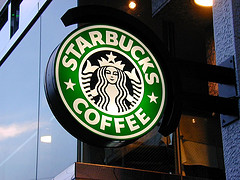The Starbucks coffee shop franchise has developed into a corporate juggernaut and has set the standard for coffee retailers across the globe. With over 16,000 store locations, Starbucks grossed over $10 billion in 2011. They continue to grow and serve over 40 countries. There is no easy answer to how this company has been able to achieve such global, fiscal success in its relatively brief lifetime. However, a few factors throughout its history have clearly enabled Starbucks to excel above all other competitors and achieve domination over other coffee retailers.
Starbucks History

Personal Coffee
When CEO Schultz was asked about the company’s success, he attributed it to the personalization that Starbucks offers compared to the standard drinks of store retailers. Schultz stated, “Our product is not sitting on a supermarket shelf like a can of soda. Our people have done a wonderful job of knowing your drink, your name, and your kids’ names.” In other words, they treat customers like people rather than simply ATM machines.
Coffee Variety
Starbucks offers its customers a variety of coffee flavors and packages to which no other coffee retailer can match. For example, Starbucks has the 18-Count Variety Pack on its menu. This package contains 6 different blends and results in over 18 different variations of flavors after coffee brewing. This sort of flavor ingenuity resonated in foreign countries, whose restaurant menus are typically much smaller than American restaurant menus. They like options. For instance, Starbucks has over 500 locations in China and all of these locations are more profitable than U.S. counterparts.
Social Image
Starbucks provides a homey, social environment for its customers. People can come to Starbucks to study, talk with friends, or read. The décor usually consist of plenty of tables, chairs, and a friendly atmosphere. Starbucks pioneered the idea of free Wi-Fi and always has plenty of electrical outlets for laptop chargers. These conveniences establish a trendy atmosphere consistent with the expectations of social meeting places.
Transcendental Values
Schultz actually published a book explaining why his company has been so successful over the years. The book, entitled Pour Your Heart Into It: How Starbucks Built a Company One Cup at a Time emphasizes transcendental advantages that Starbucks has over its competitors. He makes an argument that company values and employee relationships keep customers coming back for more.
From Amazon:
- The Starbucks Experience: 5 Principles for Turning Ordinary Into Extraordinary
- How Starbucks Saved My Life: A Son of Privilege Learns to Live Like Everyone Else
- It’s Not About the Coffee: Lessons on Putting People First from a Life at Starbucks
See Also:
This article was composed by TJ Barea, a freelancer based in the metro area of Sacramento; along with Starbucks business strategies he is also quite familiar with single serve espresso machines and other such devices.
